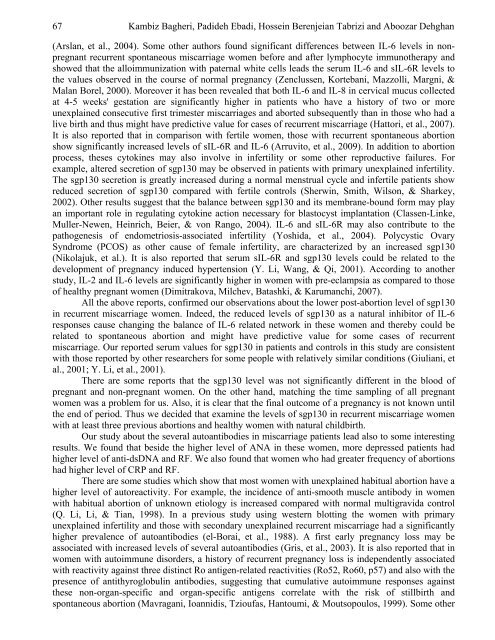Decreased Circulating Level of Soluble Glycoprotein ... - EuroJournals
Decreased Circulating Level of Soluble Glycoprotein ... - EuroJournals
Decreased Circulating Level of Soluble Glycoprotein ... - EuroJournals
Create successful ePaper yourself
Turn your PDF publications into a flip-book with our unique Google optimized e-Paper software.
67 Kambiz Bagheri, Padideh Ebadi, Hossein Berenjeian Tabrizi and Aboozar Dehghan<br />
(Arslan, et al., 2004). Some other authors found significant differences between IL-6 levels in nonpregnant<br />
recurrent spontaneous miscarriage women before and after lymphocyte immunotherapy and<br />
showed that the alloimmunization with paternal white cells leads the serum IL-6 and sIL-6R levels to<br />
the values observed in the course <strong>of</strong> normal pregnancy (Zenclussen, Kortebani, Mazzolli, Margni, &<br />
Malan Borel, 2000). Moreover it has been revealed that both IL-6 and IL-8 in cervical mucus collected<br />
at 4-5 weeks' gestation are significantly higher in patients who have a history <strong>of</strong> two or more<br />
unexplained consecutive first trimester miscarriages and aborted subsequently than in those who had a<br />
live birth and thus might have predictive value for cases <strong>of</strong> recurrent miscarriage (Hattori, et al., 2007).<br />
It is also reported that in comparison with fertile women, those with recurrent spontaneous abortion<br />
show significantly increased levels <strong>of</strong> sIL-6R and IL-6 (Arruvito, et al., 2009). In addition to abortion<br />
process, theses cytokines may also involve in infertility or some other reproductive failures. For<br />
example, altered secretion <strong>of</strong> sgp130 may be observed in patients with primary unexplained infertility.<br />
The sgp130 secretion is greatly increased during a normal menstrual cycle and infertile patients show<br />
reduced secretion <strong>of</strong> sgp130 compared with fertile controls (Sherwin, Smith, Wilson, & Sharkey,<br />
2002). Other results suggest that the balance between sgp130 and its membrane-bound form may play<br />
an important role in regulating cytokine action necessary for blastocyst implantation (Classen-Linke,<br />
Muller-Newen, Heinrich, Beier, & von Rango, 2004). IL-6 and sIL-6R may also contribute to the<br />
pathogenesis <strong>of</strong> endometriosis-associated infertility (Yoshida, et al., 2004). Polycystic Ovary<br />
Syndrome (PCOS) as other cause <strong>of</strong> female infertility, are characterized by an increased sgp130<br />
(Nikolajuk, et al.). It is also reported that serum sIL-6R and sgp130 levels could be related to the<br />
development <strong>of</strong> pregnancy induced hypertension (Y. Li, Wang, & Qi, 2001). According to another<br />
study, IL-2 and IL-6 levels are significantly higher in women with pre-eclampsia as compared to those<br />
<strong>of</strong> healthy pregnant women (Dimitrakova, Milchev, Batashki, & Karumanchi, 2007).<br />
All the above reports, confirmed our observations about the lower post-abortion level <strong>of</strong> sgp130<br />
in recurrent miscarriage women. Indeed, the reduced levels <strong>of</strong> sgp130 as a natural inhibitor <strong>of</strong> IL-6<br />
responses cause changing the balance <strong>of</strong> IL-6 related network in these women and thereby could be<br />
related to spontaneous abortion and might have predictive value for some cases <strong>of</strong> recurrent<br />
miscarriage. Our reported serum values for sgp130 in patients and controls in this study are consistent<br />
with those reported by other researchers for some people with relatively similar conditions (Giuliani, et<br />
al., 2001; Y. Li, et al., 2001).<br />
There are some reports that the sgp130 level was not significantly different in the blood <strong>of</strong><br />
pregnant and non-pregnant women. On the other hand, matching the time sampling <strong>of</strong> all pregnant<br />
women was a problem for us. Also, it is clear that the final outcome <strong>of</strong> a pregnancy is not known until<br />
the end <strong>of</strong> period. Thus we decided that examine the levels <strong>of</strong> sgp130 in recurrent miscarriage women<br />
with at least three previous abortions and healthy women with natural childbirth.<br />
Our study about the several autoantibodies in miscarriage patients lead also to some interesting<br />
results. We found that beside the higher level <strong>of</strong> ANA in these women, more depressed patients had<br />
higher level <strong>of</strong> anti-dsDNA and RF. We also found that women who had greater frequency <strong>of</strong> abortions<br />
had higher level <strong>of</strong> CRP and RF.<br />
There are some studies which show that most women with unexplained habitual abortion have a<br />
higher level <strong>of</strong> autoreactivity. For example, the incidence <strong>of</strong> anti-smooth muscle antibody in women<br />
with habitual abortion <strong>of</strong> unknown etiology is increased compared with normal multigravida control<br />
(Q. Li, Li, & Tian, 1998). In a previous study using western blotting the women with primary<br />
unexplained infertility and those with secondary unexplained recurrent miscarriage had a significantly<br />
higher prevalence <strong>of</strong> autoantibodies (el-Borai, et al., 1988). A first early pregnancy loss may be<br />
associated with increased levels <strong>of</strong> several autoantibodies (Gris, et al., 2003). It is also reported that in<br />
women with autoimmune disorders, a history <strong>of</strong> recurrent pregnancy loss is independently associated<br />
with reactivity against three distinct Ro antigen-related reactivities (Ro52, Ro60, p57) and also with the<br />
presence <strong>of</strong> antithyroglobulin antibodies, suggesting that cumulative autoimmune responses against<br />
these non-organ-specific and organ-specific antigens correlate with the risk <strong>of</strong> stillbirth and<br />
spontaneous abortion (Mavragani, Ioannidis, Tzioufas, Hantoumi, & Moutsopoulos, 1999). Some other
















